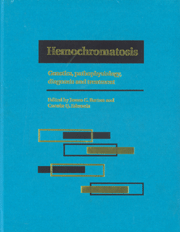Book contents
- Frontmatter
- Contents
- List of contributors
- Foreword
- Part I Introduction to hemochromatosis
- Part II Genetics of hemochromatosis
- Part III Metal absorption and metabolism in hemochromatosis
- Part IV Diagnostic techniques for iron overload
- Part V Complications of iron overload
- Part VI Therapy of hemochromatosis and iron overload
- Part VII Infections and immunity in hemochromatosis
- Part VIII Hemochromatosis heterozygotes
- Part IX Relationship of hemochromatosis to other disorders
- Part X Animal models of hemochromatosis and iron overload
- Part XI Screening for hemochromatosis
- Part XII Hemochromatosis: societal and ethical issues
- 52 Hemochromatosis: effect of iron fortification of foods
- 53 Evidence for population-based testing for hemochromatosis
- 54 Ethical issues and hemochromatosis
- 55 Hemochromatosis patients as blood and tissue donors
- 56 Genetic counseling for hemochromatosis
- Part XIII Final issues
- Index
55 - Hemochromatosis patients as blood and tissue donors
from Part XII - Hemochromatosis: societal and ethical issues
Published online by Cambridge University Press: 05 August 2011
- Frontmatter
- Contents
- List of contributors
- Foreword
- Part I Introduction to hemochromatosis
- Part II Genetics of hemochromatosis
- Part III Metal absorption and metabolism in hemochromatosis
- Part IV Diagnostic techniques for iron overload
- Part V Complications of iron overload
- Part VI Therapy of hemochromatosis and iron overload
- Part VII Infections and immunity in hemochromatosis
- Part VIII Hemochromatosis heterozygotes
- Part IX Relationship of hemochromatosis to other disorders
- Part X Animal models of hemochromatosis and iron overload
- Part XI Screening for hemochromatosis
- Part XII Hemochromatosis: societal and ethical issues
- 52 Hemochromatosis: effect of iron fortification of foods
- 53 Evidence for population-based testing for hemochromatosis
- 54 Ethical issues and hemochromatosis
- 55 Hemochromatosis patients as blood and tissue donors
- 56 Genetic counseling for hemochromatosis
- Part XIII Final issues
- Index
Summary
Introduction
Hemochromatosis, the prevalence of which is estimated to be 1 in 250 persons, is the most common inherited disorder of Caucasians. The prognosis for persons with hemochromatosis depends on the amount of iron they accumulate and the duration of their iron overload. The most effective treatment of this genetic disorder is therapeutic phlebotomy which removes approximately 200 mg of iron with every unit (500 ml) of blood. Many persons with hemochromatosis might qualify as volunteer blood donors. Because these presumably healthy patients undergo repeated, lifelong therapeutic phlebotomy, blood collected from them has the potential to enhance the blood supply in the United States (US).
The use of blood from individuals with hemochromatosis for transfusion in the US is impeded by a provision in the Food and Drug Administration's Code of Federal Regulation (Title 21 640.3(d)) that states:
Blood withdrawn in order to promote the health of the donor otherwise qualified …, shall not be used as a source of Whole Blood unless the container label conspicuously indicates the donor's disease that necessitates the withdrawal of blood.
Thus, the practice of transfusing blood that has been drawn from patients with hemochromatosis with therapeutic intent is allowed, but the source of the blood must be specified on the label. Accordingly, the clinician is alerted that the particular unit of blood has a ‘disease association’ and is therefore different from the usual unit drawn from a volunteer donor. It is left to the clinician to approve the use of the blood and to explain the significance of this labeling difference to the intended recipient as part of the informed consent process.
- Type
- Chapter
- Information
- HemochromatosisGenetics, Pathophysiology, Diagnosis and Treatment, pp. 564 - 573Publisher: Cambridge University PressPrint publication year: 2000



